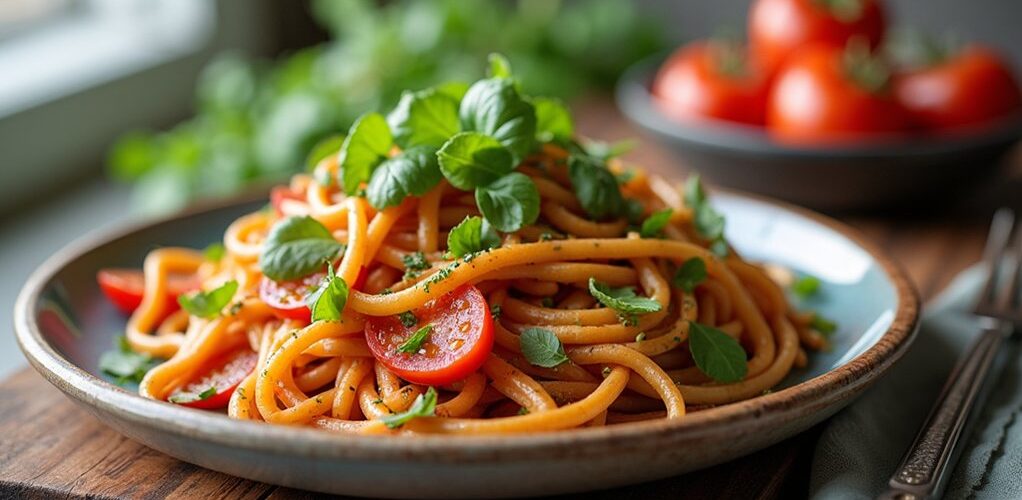
Low-carb rice alternatives offer simple, healthy substitutes using vegetables like cauliflower, zucchini, and broccoli. Using a food processor or box grater, these vegetables can be transformed into rice-sized pieces and sautéed with seasonings for 3-5 minutes until tender. Cauliflower rice contains only 5 grams of carbs per cup compared to regular rice's 45 grams, making it ideal for keto and low-carb diets. These alternatives open up a world of creative culinary possibilities.
Key Takeaways
- Process fresh cauliflower in a food processor until rice-sized, then sauté with oil for 3-5 minutes for a classic low-carb rice substitute.
- Combine riced vegetables like cauliflower, broccoli, and zucchini for varied textures and enhanced nutritional benefits in your dishes.
- Season low-carb rice alternatives with garlic, herbs, or Asian-inspired spices to create flavorful dishes without adding carbohydrates.
- Use proper storage techniques by keeping raw cauliflower rice fresh for 10 days or freezing cooked portions for up to 3 months.
- Consider shirataki rice made from konjac root for an extremely low-calorie option that mimics traditional rice texture.
Understanding Popular Low-Carb Rice Alternatives
As the demand for low-carb alternatives continues to grow, several innovative rice substitutes have emerged to satisfy health-conscious consumers. Cauliflower rice leads the pack as a versatile option for low carb dieters, containing just 5 grams of carbohydrates per cup while delivering essential nutrients like vitamins C and K. Beyond traditional cauliflower recipes, other alternatives include zucchini rice, which offers similar texture with minimal calories, and broccoli rice, providing additional nutritional benefits. For those seeking variety, shirataki rice derived from konjac root presents an extremely low-calorie option, particularly popular in Asian cuisines. Known for their unique textures, options like spaghetti squash and cabbage noodles offer additional diversity in meal preparation. Riced cabbage rounds out these alternatives, offering a pleasant crunch and antioxidant properties while maintaining the versatility needed for diverse cooking applications.
Essential Equipment and Tools for Preparation
Several essential kitchen tools are required to successfully prepare low-carb rice alternatives, with a food processor standing as the most vital piece of equipment for achieving consistent, rice-like texture.
While manual methods exist, having the right tools guarantees ideal results and efficiency in preparation, storage, and cooking.
- A food processor with an S-shaped steel blade offers the quickest and most uniform results for creating cauliflower rice.
- A non-stick pan or large skillet enables even cooking and prevents sticking during preparation.
- Airtight containers maintain freshness for both raw and cooked low-carb rice alternatives.
- Alternative tools like box graters or sharp knives can serve as backup options when a food processor isn't available.
These essential tools help streamline the preparation process while guaranteeing consistent quality in your low-carb rice alternatives.
Step-by-Step Guide to Making Cauliflower Rice
Creating cauliflower rice requires two primary pieces of equipment: a food processor with an S-shaped blade or a box grater for manual processing.
The preparation begins with a fresh head of cauliflower, which must be cleaned and trimmed of leaves and stems before being cut into florets suitable for processing.
These florets are then transformed into rice-sized pieces by pulsing them in the food processor or grating them by hand, creating a versatile base for low-carb meals.
Essential Equipment Needed
The right equipment plays an essential role in transforming cauliflower into a convincing rice substitute, with several effective options available to home cooks.
The most efficient method involves using a food processor equipped with an S-shaped steel blade, which quickly transforms cauliflower florets into uniform, rice-sized pieces through controlled pulsing.
- Food processor with S-shaped steel blade for ideal, uniform results
- Box grater for manual processing when a food processor isn't available
- Sharp knife for basic chopping, though results may be less consistent
- Large skillet or sauté pan for cooking the riced cauliflower
While each tool can produce riced cauliflower, the food processor offers the best combination of speed, consistency, and control, making it the preferred choice for regular preparation of this versatile low-carb alternative.
Processing Fresh Cauliflower
Transforming fresh cauliflower into rice-sized granules requires precise preparation techniques to achieve the ideal texture and consistency. The process begins by removing the leaves and stem from the cauliflower head, followed by cutting it into manageable florets.
To make cauliflower rice, a food processor equipped with an S-shaped blade offers the most efficient method. Process the florets in batches, pulsing until they reach a rice-like consistency.
Alternatively, a box grater can be used, though this method requires more time and effort. Once processed, the cauliflower rice can be sautéed with oil and seasonings for 3-5 minutes until tender but not mushy.
For future use, store the processed cauliflower rice in an airtight container, keeping it refrigerated for up to 10 days or frozen for up to 3 months.
Mastering Zucchini and Broccoli Rice Variations
Creating flavorful zucchini and broccoli rice variations begins with proper preparation techniques, including draining excess moisture from zucchini and achieving the ideal texture through careful food processor pulsing. These vegetable-based alternatives welcome a range of seasonings, from classic garlic and herbs to bold Asian-inspired combinations with ginger and sesame oil, allowing for diverse meal options throughout the week. Both zucchini and broccoli rice can be prepared in advance and stored in airtight containers for up to five days, making them excellent candidates for meal prep and quick weeknight dinners. Proper hydration and electrolytes are essential when incorporating these low-carb options into a keto diet to prevent potential deficiencies and maintain energy levels.
Preparing Fresh Veggie Rice
Mastering fresh veggie rice alternatives opens up a world of low-carb possibilities, with zucchini and broccoli serving as excellent foundations for rice-like dishes.
These nutrient-rich options provide substantial health benefits while maintaining satisfying textures and versatility in various recipes. Proper preparation techniques guarantee ideal results, particularly when managing moisture content and achieving the perfect consistency.
- Process zucchini or broccoli in a food processor until reaching rice-sized pieces.
- Salt and drain zucchini rice thoroughly to prevent excess moisture.
- Sauté the prepared veggie rice in oil for 3-5 minutes until tender.
- Season with preferred herbs and spices to enhance flavor profiles.
Both zucchini rice and broccoli rice offer excellent nutritional profiles, with zucchini containing just 4 grams of carbs per cup and broccoli providing 6 grams, along with beneficial vitamins and fiber.
Best Seasoning Combinations
While the foundation of vegetable-based rice alternatives lies in proper preparation, the art of seasoning these dishes enhances them from simple substitutes to crave-worthy meals.
For versatile seasoning combinations, zucchini rice shines when combined with garlic powder, onion powder, and Italian herbs, creating a Mediterranean-inspired profile.
Broccoli rice achieves a zesty, cheese-like flavor through the addition of lemon juice and nutritional yeast, complemented by crushed red pepper for heat.
Both varieties benefit from sautéing in healthy oils like olive or coconut oil, which enhance their natural flavors.
Creative cauliflower rice recipes can incorporate bold spices such as smoked paprika or curry powder, while fresh herbs like parsley and cilantro add brightness and aromatic depth to any vegetable rice variation.
Storage and Meal Planning
Successful meal planning with zucchini and broccoli rice begins with proper storage techniques to maintain freshness and convenience. Understanding proper storage methods allows home cooks to incorporate these low-carb alternatives efficiently into their weekly meal preparations, similar to frozen cauliflower rice.
Raw versions can remain fresh for up to five days when refrigerated, while cooked portions last three to four days in airtight containers.
- Store raw rice in sealed containers with paper towels to absorb excess moisture
- Portion cooked rice into individual servings before freezing for up to 3 months
- Label storage bags with dates and quantities for efficient meal planning
- Keep frozen portions in heavy-duty freezer bags, removing as much air as possible
These storage practices guarantee that healthy, low-carb alternatives are always ready for quick meal assembly.
Seasoning Techniques for Enhanced Flavor
Transforming low-carb rice into a flavorful dish requires strategic seasoning techniques that enhance both taste and nutritional value.
Basic seasoning techniques begin with aromatic foundations of fresh garlic and ginger, which create a robust flavor base for cauliflower rice while adding health benefits. The addition of spices like cumin, paprika, or curry powder allows cooks to customize their dishes according to specific cuisine styles.
For umami depth, incorporating low-sodium soy sauce creates a savory profile similar to traditional rice dishes.
Fresh herbs introduced at the final cooking stage provide brightness and visual appeal, while creative additions like coconut milk or nutritional yeast can introduce creaminess and richness.
These intentional layering methods transform simple cauliflower rice into a satisfying, flavorful alternative to traditional grains.
Storage and Meal Prep Strategies
Proper storage and meal prep strategies play a crucial role in maintaining the quality and convenience of low-carb rice alternatives. When storing cauliflower rice, fresh raw portions remain viable for up to 10 days in airtight containers within the refrigerator, while cooked cauliflower stays fresh for approximately 4 days.
Keep your cauliflower rice fresh by storing raw portions for up to 10 days and cooked portions for 4 days in sealed containers.
For extended preservation, freezing offers an excellent solution, keeping the rice viable for up to 3 months when properly sealed and dated.
- Store raw cauliflower rice in airtight containers with clear date labels
- Batch cook during weekend meal prep sessions for weekday convenience
- Freeze portioned amounts in sealed bags after complete cooling
- Thaw overnight before reheating in microwave or skillet for best texture
Best Cooking Methods for Different Rice Alternatives
When preparing low-carb rice alternatives, selecting the ideal cooking method for each type guarantees superior texture and taste. For cauliflower rice, the most efficient approach involves using a food processor with an S-blade, processing 2-3 florets at a time for uniform results. While pre-riced cauliflower offers convenience, making it fresh guarantees prime flavor and texture.
| Method | Equipment | Time Required |
|---|---|---|
| Food Processor | S-blade attachment | 5 minutes |
| Box Grater | Manual grater | 15 minutes |
| Knife Chopping | Sharp knife | 20 minutes |
After processing, sauté the low carb rice substitute in a pan with oil for 3-5 minutes, adding preferred seasonings. This quick cooking method prevents mushiness while allowing the flavors to develop fully.
Pairing Low-Carb Rice With Main Dishes
Low-carb rice alternatives open up endless possibilities for creative meal pairings, from hearty meat-based dishes to vibrant rice bowls filled with fresh vegetables and proteins.
The versatility of cauliflower rice makes it particularly suitable for quick stir-fries, where it readily absorbs the flavors of sauces while maintaining its texture and nutritional benefits.
Whether creating Asian-inspired bowls with grilled salmon and sesame sauce, or Mediterranean dishes with roasted vegetables and herbs, these rice alternatives provide a satisfying foundation for countless flavor combinations.
Meat-Based Entree Suggestions
Selecting the right protein pairing can transform a simple low-carb rice dish into a satisfying, complete meal.
Cauliflower rice serves as an excellent foundation for various meat-based entrees, offering versatility and nutritional benefits while maintaining a low-carb profile. The light texture and neutral flavor of cauliflower rice make it an ideal complement to both lean and rich protein sources.
- Grilled chicken or shrimp paired with basic cauliflower rice creates a light yet protein-rich meal.
- Beef stroganoff served over riced cauliflower offers a keto-friendly twist on the classic comfort dish.
- Ground turkey or pork combined with cauliflower rice works perfectly in stuffed bell peppers.
- Grilled steak or carne asada accompanied by Mexican-style cauliflower rice delivers a flavorful, carb-conscious dinner option.
Rice Bowl Flavor Combinations
Building upon the foundation of protein pairings, rice bowl combinations offer endless possibilities for creating satisfying low-carb meals.
Cauliflower rice serves as a versatile base for diverse flavor combinations, ranging from Asian-inspired dishes with shrimp and soy sauce to Mexican-themed bowls featuring black beans and avocado.
For those seeking international flavors, an Italian variation combines marinara sauce and Parmesan cheese with the cauliflower rice base, while a Mediterranean-style bowl incorporates tahini dressing and roasted vegetables.
Health-conscious diners can enjoy a revitalizing option by pairing the low-carb rice with grilled chicken and cilantro lime dressing.
These creative combinations demonstrate how cauliflower rice can adapt to various cuisines while maintaining its nutritional benefits, proving that reducing carbohydrates doesn't mean sacrificing taste or satisfaction.
Quick Stir-Fry Pairings
When exploring quick stir-fry options, cauliflower rice proves to be an exceptional foundation for creating satisfying meals that come together in minutes.
This versatile low-carb alternative readily absorbs flavors while complementing various proteins and vegetables, making it ideal for weeknight cooking.
- Combine cauliflower rice with colorful bell peppers, snap peas, and broccoli for a nutrient-rich stir-fry base.
- Add protein options like chicken, shrimp, or tofu, enhancing the dish's nutritional profile.
- Incorporate fresh aromatics such as minced garlic and ginger, along with gluten-free soy sauce or tamari.
- Mix in scrambled eggs for an extra protein boost, creating a complete low-carb meal.
Pre-preparing and freezing cauliflower rice in batches streamlines the cooking process, enabling quick and convenient stir-fry preparation any day of the week.
Creative Recipe Ideas and Adaptations
Transform ordinary cauliflower rice into exciting culinary creations through an array of creative adaptations and recipe variations. This versatile, lower in carbs alternative accommodates diverse flavor profiles, from golden turmeric-spiced dishes to zesty cilantro-lime combinations.
Creative recipe ideas include incorporating colorful vegetables like bell peppers and peas, which enhance both nutritional value and visual appeal.
For heartier options, cauliflower rice serves as an excellent base for make-ahead casseroles or a vibrant Tex-Mex inspired dish with black beans, tomatoes, and jalapeños.
Adventurous cooks can explore sweet applications by incorporating cauliflower rice into smoothies or energy bites, demonstrating its remarkable adaptability beyond savory dishes while maintaining its health-conscious appeal.
Cauliflower rice is a staple for those on a keto diet as it helps maintain a low-carb intake while still allowing for a wide variety of delicious and satisfying meals.
Nutritional Benefits and Comparison Guide
Delving into the nutritional profile of cauliflower rice reveals compelling advantages over traditional rice varieties, particularly for those monitoring their carbohydrate intake. As a low-carb alternative, cauliflower rice contains just 5 grams of carbohydrates per cup, compared to traditional rice's 45 grams, while delivering essential nutrients and antioxidants that support overall health. Significant calorie reduction with only 25 calories per cup versus 200 calories in white rice. Rich source of vitamins C, K, and B6, plus potassium for immune function. High fiber content promotes digestive health and blood sugar stability. Contains antioxidants that help reduce inflammation and oxidative stress. Protein's role in muscle maintenance during ketosis is crucial, making cauliflower rice a complementary choice for those on a ketogenic diet. These nutritional benefits make cauliflower rice an excellent choice for health-conscious individuals seeking to maintain a balanced, nutrient-rich diet while reducing carbohydrate intake.
Troubleshooting Common Texture Issues
Although achieving the perfect texture with cauliflower rice may present challenges, understanding common issues and their solutions can help home cooks create a satisfying low-carb alternative. The key to success lies in managing moisture content and cooking time effectively. To prevent mushiness, cook the cauliflower rice briefly, using high heat for just 3-5 minutes while stirring occasionally.
| Issue | Cause | Solution |
|---|---|---|
| Mushy Texture | Overcooking | Limit cooking time to 3-5 minutes |
| Watery Results | Excess Moisture | Use cheesecloth to remove water |
| Inconsistent Size | Poor Processing | Pulse carefully in food processor |
| Soggy Bottom | Inadequate Pan Size | Choose large skillet for better evaporation |
Proper preparation techniques, including wringing out excess moisture and using appropriate cookware, guarantee ideal texture and prevent common pitfalls in cauliflower rice preparation.
Time-Saving Tips and Shortcuts
Several time-saving strategies can streamline the process of making low-carb cauliflower rice, making it a practical option for busy home cooks.
Using a food processor equipped with an S-blade transforms whole cauliflower into uniform rice-sized pieces in mere seconds, while pre-riced cauliflower from grocery stores eliminates preparation time entirely.
- Process cauliflower in smaller batches to guarantee even results and prevent processor overflow.
- Store leftover cauliflower rice in airtight containers for quick access throughout the week.
- Purchase pre-riced cauliflower when time is limited or kitchen equipment is unavailable.
- Freeze portions in measured quantities for convenient meal preparation within a three-month window.
These efficient approaches help maintain a steady supply of cauliflower rice while minimizing preparation time and effort.
Frequently Asked Questions
How to Eat Rice on a Low-Carb Diet?
Individuals can enjoy low carb alternatives by replacing traditional rice with rice substitutes like cauliflower rice, zucchini rice, or other healthy grains such as quinoa in smaller portions.
What Is a Good Low-Carb Replacement for Rice?
Several effective low-carb rice alternatives include cauliflower rice, which provides nutrients and fiber, zucchini rice for its mild flavor, and shirataki rice, which contains minimal carbohydrates and calories.
How to Make Rice Have Less Carbs?
Reducing rice carbs involves exploring rice alternatives like cauliflower rice, implementing carb reduction techniques through portion control, and utilizing specific cooking techniques such as rinsing rice before cooking.
How to Make Plain White Rice Interesting?
Transform plain rice by creating spicy rice with aromatics and seasonings, mixing in colorful veggie stir fry combinations, or preparing creamy coconut rice with fresh herbs and toasted nuts.
Conclusion
Creating low-carb rice alternatives offers a versatile solution for health-conscious individuals seeking to reduce their carbohydrate intake while maintaining familiar meal experiences. Through simple techniques and readily available ingredients like cauliflower, zucchini, and broccoli, anyone can prepare satisfying rice substitutes. With proper preparation methods, creative seasonings, and careful attention to texture, these alternatives provide nutritious options that seamlessly integrate into various cuisines and dietary preferences.
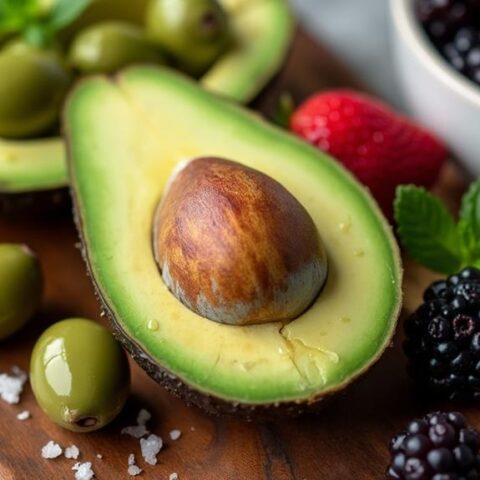

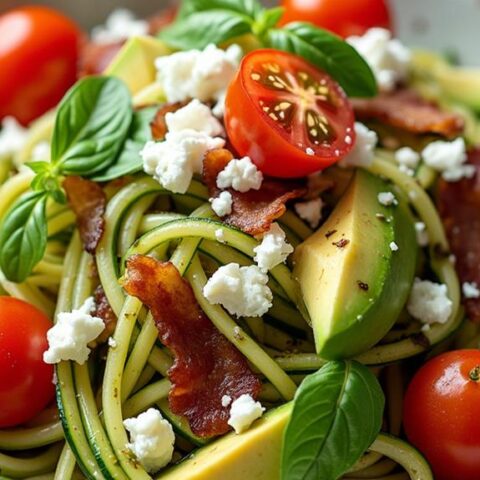

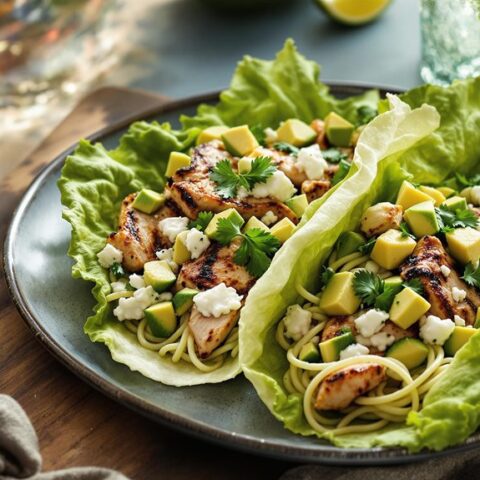
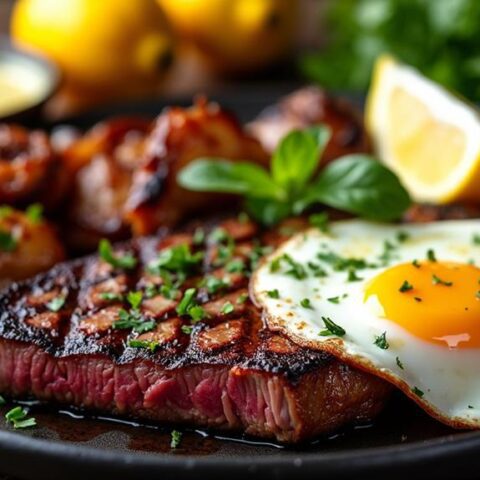
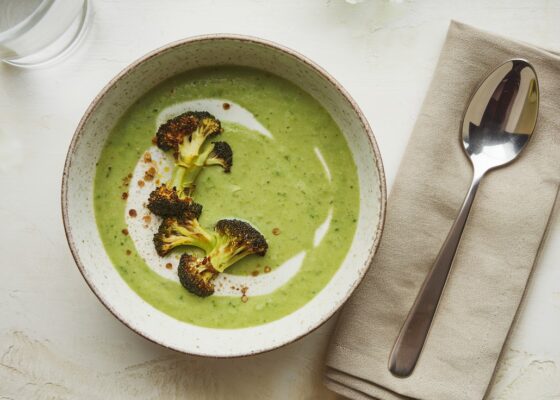

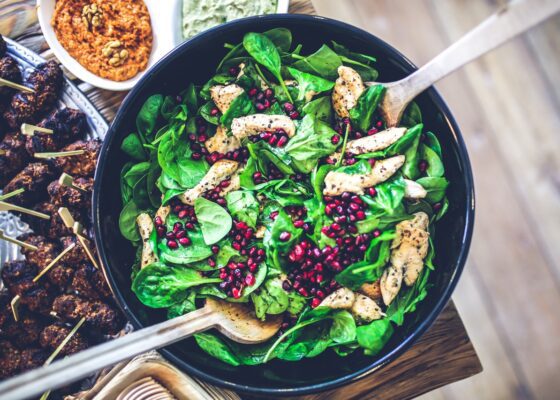
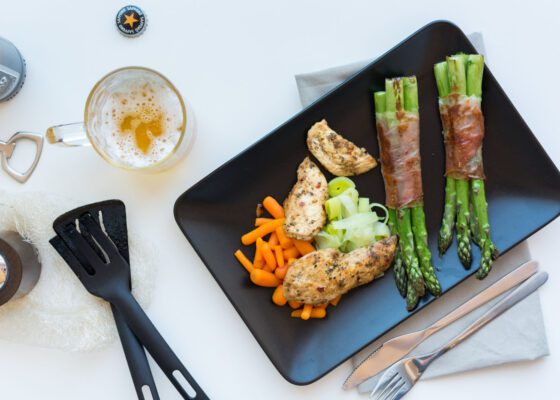
No Comments